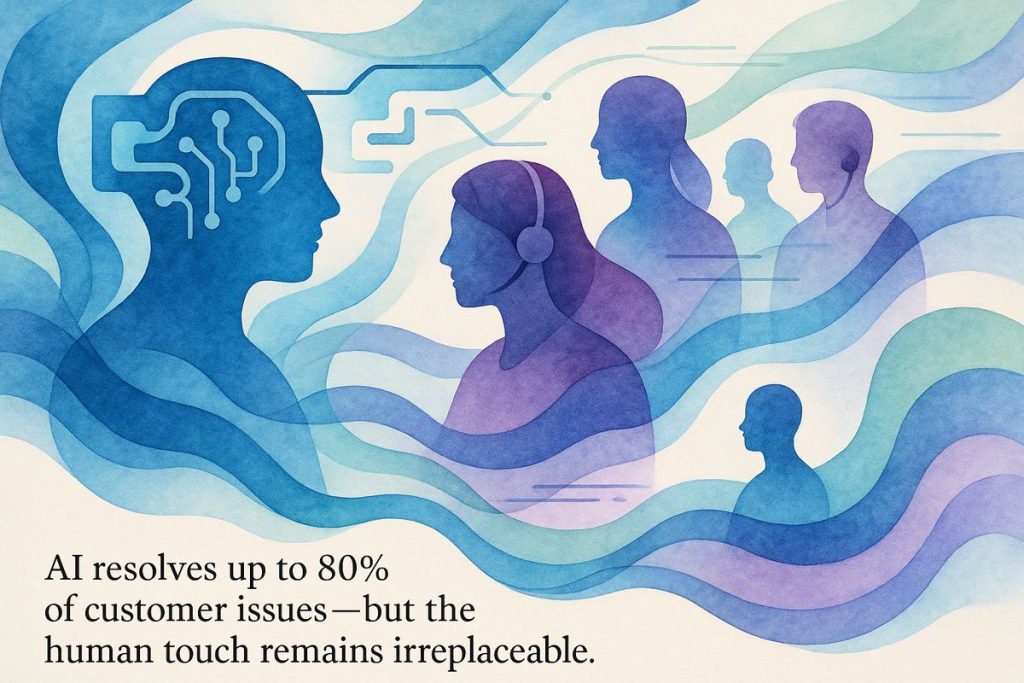In 2025, AI call centers will be a lively mix of smart computers and real people working together. The AI will quickly handle easy, everyday questions, making things faster and smoother, while human agents will step in for tricky problems that need empathy or special care, especially in areas like healthcare. The industry is growing super fast, with more companies using AI every year, but humans are still needed for their unique understanding and emotion. Despite all the high-tech changes, some old systems still stick around, and there’s a big focus on making sure rules are followed, especially where mistakes can be costly. In the end, it’s clear that the best help happens when humans and AI join forces.
What will AI call centers look like in 2025?
AI call centers in 2025 will feature a human-AI hybrid model, where artificial intelligence handles routine tasks, increasing efficiency and reducing resolution times by up to 50%, while human agents focus on complex, nuanced cases requiring empathy and oversight, especially in regulated industries like pharma.
The year is 2025, and the call center is no longer a beige-walled purgatory of hold music and headset hair. Instead, it’s a palimpsest of the old and the new—flickering on the screen are hyperspectral dashboards, while somewhere, a human agent sips tepid coffee and waits for the next complex case. The industry is humming with change, its transformation as unmistakable as the smell of burnt toast at 7 a.m. (an aroma that, for some reason, always reminds me of my first shift in a BPO back in 2012).
A Market That’s Boiling Over
Let’s not mince numbers: the global AI call center market is careening from $3.7 billion in 2023 to a projected $100 billion by 2032, clocking an annual growth rate that would make even the most caffeinated startup founder blink—over 40% (source). If you squint, you can almost see the dollar signs stacking up like poker chips in a Monte Carlo back room. As of this year, 80% of companies have either deployed AI-powered chatbots or have their fingers poised above the “implement” button (Zendesk; Coherent Solutions). Life sciences giants like Roche and Novartis are at the forefront, drawn by AI’s promise to juggle compliance, mountains of data, and the occasional regulatory curveball.
And yet, amidst the digital fireworks, I often wonder—are we moving too fast for our own good? Is there a risk that we’re so entranced by this shiny algorithmic future that we’ll forget the peculiar magic of a human voice on a bad day?
Operations: When Algorithms Meet Actual People
AI in the call center has shifted from hyped prototype to practical workhorse. You want numbers? Try these on for size: resolution times have dived by up to 50%, and ticket handling is up by a comparable margin (Sobot; Rezo.ai). I recall a pilot with Customertimes where a single glitchy bot (let’s call him Vladislav) managed to route 2,000 queries in a single day, miscategorizing only 3%—not perfect, but impressive enough to make our senior engineer do a double take. Bam!
But it’s not all smooth sailing. In pharma, where compliance documents pile up faster than Moscow snow in February, AI scrubs through adverse event reports in real time, generating regulatory records with an accuracy that’s almost eerie. At the same time, speech analytics tools—think NICE or Verint—are picking apart conversations, seeking patterns, and delivering feedback that’s practically in stereo. I’ll admit, the first time I listened to my own calls played back by an AI, I felt a pang of embarrassment. Did I really say “um” that many times?
Some things don’t change. There’s still a whiff of anxiety in the air—will the humans become obsolete, or simply evolve?
The Human-AI Hybrid: Not Just a Buzzword
Here’s where things get interesting: despite all the breathless headlines, Blair Pleasant of COMMfusion LLC remarked (not without a smirk) that many haven’t even implemented 1990s-era screen pop technology. That’s like showing up at a Tesla factory with a horse and buggy. As for “agentic AI”—don’t hold your breath. The march toward full automation is not a sprint; it’s a winding marathon with plenty of potholes.
And yet, the hybrid model—machines for the grunt work, humans for the nuance—has emerged as the reigning champion. Half the industry once daydreamed about bots replacing humans entirely, but reality has proved stickier. Empathy, lateral thinking, and the occasional sarcastic joke? These remain the sole province of carbon-based agents (Convin). I had to stop and ask myself: would I trust a hallucinating chatbot to explain a complex insurance policy to my grandmother? Nyet.
High employee churn remains a stubborn foe. Now, with AI absorbing rote tasks, agents are nudged—sometimes shoved—into roles demanding AI oversight and emotional intelligence. There’s a learning curve, sure. Last year, I tried to train a colleague on interpreting bot-generated trend data; we both ended the session with furrowed brows and a renewed respect for data scientists. Progress.
Regulated Industries: Tightropes and Safety Nets
Pharma and life sciences are a breed apart—these aren’t industries where you can “move fast and break things.” Roche, Johnson & Johnson, and their ilk leverage AI not just for speed, but for bulletproof compliance and delicate medical queries. But the stakes are high, and a misstep could see a company’s regulatory standing evaporate faster than a Moscow snowflake in July.
For Customertimes and their ensemble of partners, caution isn’t optional—it’s a survival trait. The risk of moving too quickly, or botching the human element, is real. I remember a near miss in 2023: an overeager automation suite flagged allergy data incorrectly. We caught it, but the
